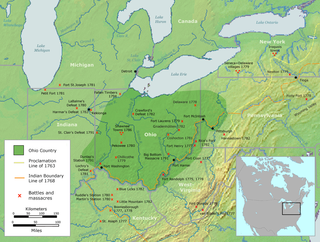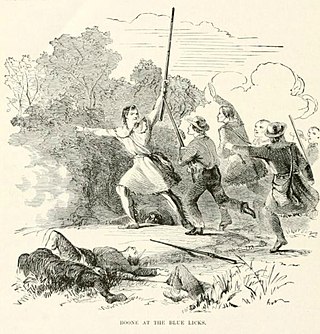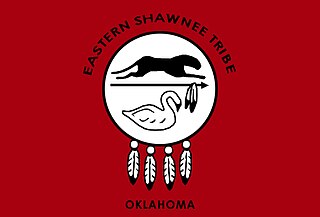
Tecumseh was a Shawnee chief and warrior who promoted resistance to the expansion of the United States onto Native American lands. A persuasive orator, Tecumseh traveled widely, forming a Native American confederacy and promoting intertribal unity. Even though his efforts to unite Native Americans ended with his death in the War of 1812, he became an iconic folk hero in American, Indigenous, and Canadian popular history.

The Treaty of Greenville, also known to Americans as the Treaty with the Wyandots, etc., but formally titled A treaty of peace between the United States of America, and the tribes of Indians called the Wyandots, Delawares, Shawanees, Ottawas, Chippewas, Pattawatimas, Miamis, Eel Rivers, Weas, Kickapoos, Piankeshaws, and Kaskaskias was a 1795 treaty between the United States and indigenous nations of the Northwest Territory, including the Wyandot and Delaware peoples, that redefined the boundary between indigenous peoples' lands and territory for European American community settlement.

The Ohio Country, was a name used for a loosely defined region of colonial North America west of the Appalachian Mountains and south of Lake Erie.

The Shawnee are an Indigenous people of the Northeastern Woodlands. Their language, Shawnee, is an Algonquian language.

Lord Dunmore's War, also known as Dunmore's War, was a brief conflict in fall 1774 between the British Colony of Virginia and the Shawnee and Mingo in the trans-Appalachian region of the colony south of the Ohio River. Broadly, the war included events between May and October 1774. The governor of Virginia during the conflict was John Murray, 4th Earl of Dunmore, who in May 1774, asked the House of Burgesses to declare a state of war with the Indians and call out the Virginia militia.

The Battle of Blue Licks, fought on August 19, 1782, was one of the last battles of the American Revolutionary War. The battle occurred ten months after Lord Cornwallis's surrender at Yorktown, which had effectively ended the war in the east. On a hill next to the Licking River in what is now Robertson County, Kentucky, a force of about 50 Loyalists along with 300 indigenous warriors ambushed and routed 182 Kentucky militiamen, who were partially led by Daniel Boone. It was the last victory for the Loyalists and natives during the frontier war. British, Loyalist and Native forces would engage in fighting with American forces once more the following month in Wheeling, West Virginia, during the Siege of Fort Henry.
Chalahgawtha was the name of one of the five divisions of the Shawnee, a Native American people, during the 18th century. It was also the name of the principal village of the division. The other four divisions were the Mekoche, Kispoko, Pekowi, and Hathawekela. Together these divisions formed the loose confederacy that was the Shawnee tribe.

Cornstalk was a Shawnee leader in the Ohio Country in the 1760s and 1770s. His name in the Shawnee language was Hokoleskwa. Little is known about his early life. He may have been born in the Province of Pennsylvania. In 1763, he reportedly led a raid against British American colonists in Pontiac's War. He first appears in historical documents in 1764, when he was one of the hostages surrendered to the British as part of the peace negotiations ending Pontiac's War.

Benjamin Logan was an American pioneer, soldier, and politician from Virginia, then Shelby County, Kentucky. As colonel of the Kentucky County, Virginia militia during the American Revolutionary War, he was second-in-command of all the trans-Appalachian Virginia. He became a politician and help secure statehood for Kentucky. His brother, John Logan, who at times served under him in the militia and replaced him as delegate, became the first state treasurer of Kentucky.

Simon Kenton was an American frontiersman and soldier in West Virginia, Kentucky, and Ohio. He was a friend of Daniel Boone, Spencer Records, Thomas S. Hinde, Thomas Hinde, and Isaac Shelby. He served the United States in the Revolution, the Northwest Indian War, and the War of 1812. Surviving multiple gauntlets and ritual torture, in 1778, he was adopted into the Shawnee people. He married twice and had a total of 11 children.

Pickrelltown is an unincorporated community in Logan County, Ohio.

Catecahassa or Black Hoof was the head civil chief of the Shawnee Indians in the Ohio Country of what became the United States. A member of the Mekoche division of the Shawnees, Black Hoof became known as a fierce warrior during the early wars between the Shawnee and encroaching American settlers. Black Hoof claimed to have been present at the Battle of the Monongahela in 1755 when General Edward Braddock was defeated during the French and Indian War, although there is no contemporary evidence that Shawnees took part in that battle.
Kispoko is the name of one of the five divisions of the Shawnee, a Native American people. The Kispoko were the smallest of the five septs or divisions during the 18th century. They lived among the Creek in the Upper South and Southeast as early as 1650, having been driven from their Ohio country homeland by the Iroquois Confederacy during the Beaver Wars. They returned to Ohio about 1759. The other four divisions were the Chalahgawtha, Mekoche, Pekowi, and Hathawekela. Together these divisions formed the loose confederacy that was the Shawnee tribe. The septs tended to serve different functions for the overall confederacy.
Pekowi was the name of one of the five divisions of the Shawnee, a Native American people, during the 18th century. The other four divisions were the Chalahgawtha, Mekoche, Kispoko, and Hathawekela. Together these divisions formed the loose confederacy that was the Shawnee tribe.
Hathawekela was one of the five divisions of the Shawnee, a Native American people during the 18th century. The other four divisions were the Chalahgawtha, Mekoche, Kispoko, and Pekowi. Together these divisions formed the loose confederacy that was the Shawnee tribe.
Snake was the English language name of two Shawnee leaders prominent in the history of the Ohio Country: Peteusha and Shemanetoo. They were both commonly referred to as "Snake" in historical records, or by variations such as "Black Snake" or "Captain Snake," so it is often difficult to determine which individual was being referred to. On a number of occasions, the two Snakes both signed a letter or appeared together, so it is clear they were two different people. There may have been additional Shawnees called "Snake," further complicating the matter. According to historian John Sugden, "it is unlikely if the biographies of these chiefs will ever be completely disentangled."

The Eastern Shawnee Tribe of Oklahoma is one of three federally recognized Shawnee tribes. They are located in Oklahoma and Missouri.

Quatawapea or John Lewis, also known as Captain Lewis and Colonel Lewis and ‘’’Captain Johnny’’’, was a Shawnee leader for whom Lewistown, Ohio, is named.
Kekewepelethy, also known as Captain Johnny, was the principal civil chief of the Shawnees in the Ohio Country during the Northwest Indian War (1786–1795). He first came to prominence during the American Revolutionary War (1775–1783), in which he, like most of his fellow Mekoche Shawnees, initially sought to remain neutral. He joined the war against the United States around 1780, moving to Wakatomika, a Shawnee town known for its militant defense of the Ohio Country.













